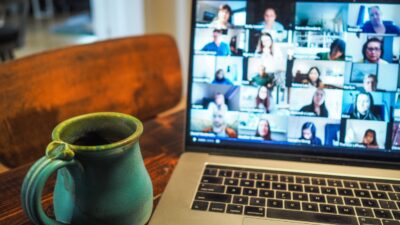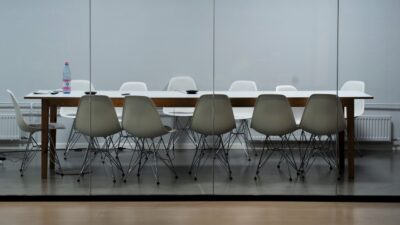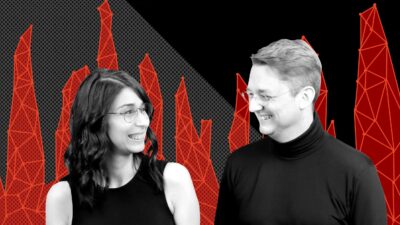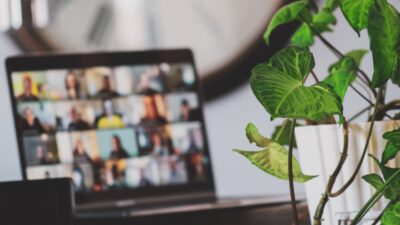Sandra Peter and Kai Riemer
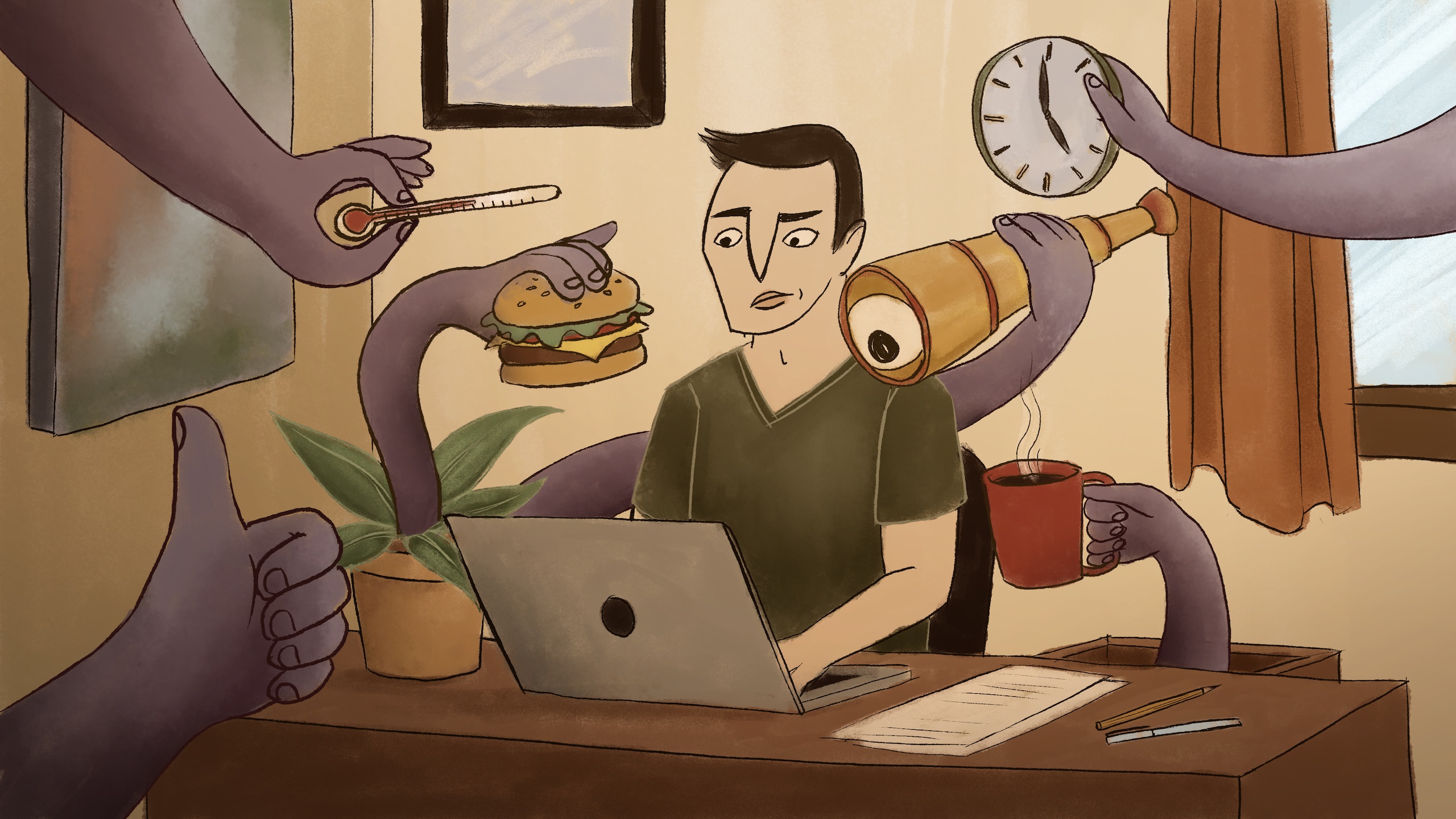
Employee monitoring on Corona Business Insights
Employee monitoring: the rise in remote worker monitoring and workplace health screening. This is part 1 of a 2-part special.
As COVID-19 sets out to change the world forever, join Sandra Peter and Kai Riemer as they think about what’s to come in the future of business.
Shownotes
This episode is part 1 of a 2-part special looking at monitoring and surveillance in the workplace. Listen to part 2.
2018 Gartner report on monitoring employee productivity
2019 Accenture survey on monitoring employee productivity
The workplace-surveillance technology boom
Your boss is watching you as you’re working from home
Employee monitoring in the NYT
HBR on how to monitor employees while respecting their privacy
Zoom disables attention tracking
PwC has developed an app that tracks how close employees get to each
Employee monitoring with daily activity points across applications
Capturing all keyboard activity for user-based behaviour analytics
Random screen captures for user-based behaviour analytics
Employee surveillance on the rise
Temperature checks in the workplace
Hospital monitoring tools for healthcare workers
Apps that ask employees to self-report their health symptoms
Our previous conversation on productivity and remote work on Corona Business Insights
Our previous conversation on the ideal worker on Corona Business Insights
Our previous conversation on contact tracing on The Future, This Week
This episode is part of a podcast series covering what COVID-19 will mean for the business world, where we look at the impact on the economy, businesses, industries, workers and society. This is part of our ongoing coverage of the impact of COVID-19 on the future of business.
Follow the show on Apple Podcasts, Spotify, Overcast, Google Podcasts, Pocket Casts or wherever you get your podcasts. You can follow Sydney Business Insights on Flipboard, LinkedIn, Twitter and WeChat to keep updated with our latest insights.
Send us your news ideas to sbi@sydney.edu.au.
Dr Sandra Peter is the Director of Sydney Executive Plus and Associate Professor at the University of Sydney Business School. Her research and practice focuses on engaging with the future in productive ways, and the impact of emerging technologies on business and society.
Kai Riemer is Professor of Information Technology and Organisation, and Director of Sydney Executive Plus at the University of Sydney Business School. Kai's research interest is in Disruptive Technologies, Enterprise Social Media, Virtual Work, Collaborative Technologies and the Philosophy of Technology.
Share
We believe in open and honest access to knowledge. We use a Creative Commons Attribution NoDerivatives licence for our articles and podcasts, so you can republish them for free, online or in print.
Transcript
This transcript is the product of an artificial intelligence - human collaboration. Any mistakes are the human's fault. (Just saying. Accurately yours, AI)
Intro From the University of Sydney Business School, this is Sydney Business Insights.
Sandra And this is Corona Business Insights. I'm Sandra Peter.
Kai And I'm Kai Riemer.
Sandra And with everything that's happening out there, it's quite hard to understand what COVID-19 will mean for the business world. So in this series, we've been unpacking business, economy, industry, government, workers and society, and looking at the effects of the pandemic.
Kai And this podcast is, of course, part of a larger initiative by the University of Sydney Business School. Our COVID business impact dashboard is a living initiative which we constantly update with insights and resources from academics, from industry experts, Nobel Prize winners, movers and shakers.
Sandra And you can find all of these resources online at sbi.sydney.edu.au/coronavirus.
Kai And today we talk about employee monitoring in the age of COVID-19.
Sandra And this episode is the first in a two-part special looking at on the one hand what has been called employee monitoring and what, on the other hand, has also been referred to as corporate surveillance. So in this two-part special we want to have a look at the same topic from two different points of view, from the organisational perspective, the managerial perspective, but also then look at it from the employee perspective.
Kai And we would like to urge you to listen to both episodes. If you haven't listened to the other one, please do it, because only then will you get a complete picture of how we see this topic.
Sandra So let's have a look now at employee monitoring.
Kai And this, of course, has been around contact tracing apps and efforts to monitor the spread of the disease in the population.
Sandra For a long time now, we've had ongoing conversations around government or police surveillance. We've had discussions about big tech companies monitoring our online behaviour, and we've had discussions around privacy breaches in this space. But relatively less attention has been paid before the COVID-19 pandemic to what organisations do in this space. And even before we all started working from home, as many of us still are today, employees were using various systems to monitor employee productivity. So, for instance, a Gartner report from two years ago revealed that of two hundred and thirty nine large corporations, about 50 percent for monitoring the content of their employees emails, their social media accounts and ways in which they utilise their workspaces. Similarly, a Accenture survey from last year reported that about 62 percent of the organisations they were looking at were leveraging various tools online to collect data on what the employees are doing and how productive they being online. So even though COVID-19, is surfacing, these conversations, these sort of practises have been used by organisations previously.
Kai But now with COVID-19 these have taken a number of forms. There's governments employing technology such as contact tracing apps to monitor the spread of the disease and to help with opening up societies. But there's also a whole slew of technologies that are now available to employers, to managers, to organisations, to monitor employees, both in terms of health-related outcomes when it comes to going back to the office and opening up buildings again, but also related to the new practises of remote working and working from home. And so we thought we look at both.
Sandra So the first category that's been quite obvious in the last few months has been that of health monitoring. And companies have been putting in place various measures depending on the types of activities they conduct. On the one hand, with companies that use, for instance, infrared cameras to conduct temperature cheques in warehouses. So Amazon, Walmart have been doing this, but also in hospitals, trying to track the health of their workers and to be able to detect cases of COVID-19.
Kai And there is more technologies in this space that are used to, for example, location track people in buildings or on premise, in warehouses, in production sites. These can either be RFID-enabled lanyards, or they can be sensors, they can be swipe cards. Anything that helps to know where people are. They can also be used in office buildings to make sure that meeting rooms are not crowded, that certain areas of the building only have the allowed number of people per square metres. So these are tracking technologies that help with contact tracing after the fact, but then also regulate people movements in buildings.
Sandra There is also a whole slew of apps that have been employed. For instance, mobile apps that ask employees to self-report. So, for instance, the report on whether or not they have a temperature. Do they have any other symptoms? And the organisation would then use this to classify what level of risk the employee poses and decide on whether or not the employees can come back to work. Another set of apps is similar to the ones that governments use to contact trace. So, for instance, PWC, one of the big accounting consulting firms has developed an app that tracks how close employees come to each other by using their smartphones, Bluetooth and Wi-Fi signals. And this is being tested in their Shanghai offices to ensure that PWC can identify employees who have come in close contact with someone who is infected with COVID-19.
Kai And while this may not be possible in every jurisdiction in the world, we can also envision that companies might mandate that employees use the government sanctioned contact tracing apps. So that, again, should there be an outbreak, this can be contained and people can be notified, can be asked to work from home to self-isolate. Which brings us to why companies would want to do this. And it's, of course, that they have a duty of care for when employees go back to the office to make sure to reduce the risk for employees. There's also a compliance aspect, of course, and the liability aspect. No company wants to be responsible for employees getting infected with COVID-19 on their premises. So there's now a whole range of technologies that can be used to monitor people, to enforce or ensure social distancing in corridors with cameras and to make sure that people are working in the safest possible environment.
Sandra But there's also been another big category of employee monitoring software that we want to focus on today. And that has to do with how people work and how productive they're being while working remotely whilst working from home.
Kai So management now faces an interesting problem, which is that most of their reports now work offsite in a distributed manner and that in order to manage effectively, people will need the information about who's doing what and how well are they going with their work, what's their work progress. And so there's now a range of technologies that help with this. It starts with the ability to monitor communication in people's inboxes or in communication solutions such as teams slack. But it goes even further than that with dedicated software that monitors how people work.
Sandra So on the one hand, corporations could monitor employees behaviours in various software applications that are required for work, whether that's your email or your word processor or other software that's used for work or could follow your movements on the Web. Whether you're shopping online or watching YouTube videos, it could log your keyboard strokes, it could log your mouse movements, the websites you visited, or companies can go as far as taking a screenshot at regular intervals, duplicating the employee screen so you can have access to what they're seeing or even enabling the cameras on their laptops or home computers.
Kai So the most comprehensive solutions will provide detailed analytics of how much time someone spends in their sanction work apps, visa every time spend outside of this on private things that are not work focussed. And so make sure that people are actually working in the time that they're claiming that they're working and to keep an eye on productivity.
Sandra There is a number of reasons why organisations would want to monitor their employees, and some of them are as simple as companies being worried about how productive employees are being at home. Let's remember, for most organisations, the rapid move to remote working wasn't planned. It was an unanticipated change that saw in some cases, hundreds of thousands of workers start to work from home for the first time with no processes in place and little experience both on behalf of the managers and the employees in how best to do this.
Kai And incidentally, we've discussed this in another episode of CBI on remote working and productivity. But that's exactly the point here, for managers, for supervisors who now have to look after a range of people who are off-site, these solutions promise to provide the necessary data to keep an eye on people's productivity, but also to help with fairness and recognition of those people who work harder than others, and identify those who might be struggling with the work from home experiment given that it is not always easy to transition from an office environment into a home environment that offers way more distractions, but also interruptions. So this software can help managers to identify those who are struggling, who might need coaching or help with their productivity, but also manage to make more visible some of the work that employees do.
Sandra For many employees, the number of hours they work from home can be invisible to their manager. We also know that for many of these people, the amount of hours that they work has gone up quite significantly, in the US that has been up by 30 to 40 percent.
Kai And the idea here is obviously to identify those who might be working too much to help people find a better work life balance and to prevent them from burnout, for example.
Sandra Well, of course, for companies employee monitoring, it's not an end in itself. So before we wrap up this episode, let's look at how organisations can do this well.
Kai So, first of all, anything that we measure needs to be relevant to the actual work. For example, just monitoring the quantity of emails that someone is reading or writing is not a good measure of productivity because many emails, for example, shouldn't be read. If we're just to measure the proportion of emails that someone reads, we would set the incentive to read emails that might be spam or that might not be relevant to the work. So we need to make sure that the metrics employed are actually contributing to the productivity in what we want to achieve.
Sandra Quite often we tend to embrace those seductive tech options that put a number on it. Quite a few of the monitoring softwares give you a productivity score or attach a number that might seem objective to how well employees are doing, but deciding what goes into that number and in what ways quantifying behaviour online might not actually be relevant or capture well what the employee is doing.
Kai The second one is that monitoring should not feel intrusive. It should not be used for punishment. It should be used in a positive way to support, to help recognise productivity and work, so that the organisation can gain the buy-in from the employees. Which also means that the usage should be well explained and outlined before a solution is being implemented.
Sandra And organisations should also monitor how well these solutions are performing under the exceptional circumstances that we're in. We know well that many employees juggle multiple responsibilities at home, whether they have to do with educating kids from home or care for elderly people or other responsibilities. There is also the chance that this will disadvantage certain groups of people over others.
Kai And this is where we want to leave it. And we encourage you to also listen to our second episode on this topic on corporate surveillance, in which we tell the story from the employee perspective.
Sandra This has been Corona Business Insights. Until next time.
Kai Thanks for listening.
Sandra Thanks for listening.
Outro From the University of Sydney Business School, this is Sydney Business Insights, the podcast that explores the future of business.
Close transcript

